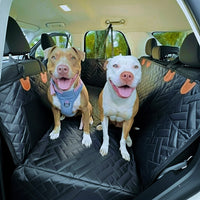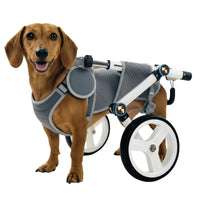
Can Dogs Get Car Sick?
Like humans, dogs undergo the same experience of getting car sick. Medically, this is referred to as motion sickness, which affects puppies and young dogs more.
As a dog owner, it is important to understand the causes of motion sickness in dogs. Once you identify the symptoms of how dogs can get car sick, you need to take preventive steps to ensure your furry friend enjoys car rides.
Why Do Dogs Get Car Sick?
The basic cause of dogs getting car sick relates to the improper formation of the internal ear organs, which control equilibrium processing. Young dogs, along with puppies, show increased sensitivity to motion sickness because their inner ear structures have not fully formed. When dogs become older, they typically develop better balance systems that make this car sickness symptom disappear.
Physical sickness does not explain every case of dog car sickness. Dogs frequently relate car travel to unpleasant events which causes them to develop nervousness that leads to car sickness. A dog experiencing nausea during its first car rides could develop this response, which leads to feeling unwell even though motion sickness is not the main reason.
Moreover, the position of a dog within a vehicle plays a role in the development of dog motion sickness. Dogs are likely to experience nausea because rapid outdoor movements create confusion between their senses when they cannot observe the outside environment. The experience is comparable to how human beings feel motion sickness while reading in a moving vehicle.
Recognizing the Symptoms of Dog Car Sickness
Early detection of dog car sickness allows owners to avoid their pet experiencing discomfort and health-related problems. Common signs include:
- Excessive drooling
- Yawning
- Whining or whimpering
- Lethargy or inactivity
- Vomiting
- Restlessness or uneasiness
- Lip licking
- The dog shows signs of pacing while attempting to leave the vehicle.
The symptoms appear either before traveling or they begin during an active car drive. Acting quickly to intervene when identifying car sickness symptoms in dogs will result in reduced discomfort.
Preventing Dog Car Sickness
Here are some simple ways on how to prevent dog sickness:
- Gradual Acclimation – Introduce your dog to the car slowly. Place the dog in a parked vehicle first and move to brief drives before expanding travel time.
- Comfortable Environment – A calm environment with low temperatures should exist inside the vehicle. Nice classical music alongside low temperatures works as an effective method to control anxiety.
- Restrict Food Before Travel – Your dog should not receive a large meal during the pre-trip feeding period. An empty stomach combined with light stomach contents minimizes the likelihood of your dog experiencing nausea symptoms.
- Use of Dog-Specific Restraints – A dog seat belt together with a well-ventilated crate enables limited movement, which helps decrease the sensitivity to motion sickness factors.
- Frequent Breaks – During extended car trips, make time for your dog to reach their feet and use the restroom, along with taking fresh breaths.
- Fresh Air – Lowering windows just a little bit creates balance in air pressure, minimizing dog motion sickness.
- Positive Reinforcement – Make positive park visits and similar activities the normal association for car rides during your training sessions.

What Can I Give My Dog for Car Sickness?
If you are wondering what to give a dog for car sickness, the following options exist when preventive measures fail to address the problem:
- Ginger – A small dose of ginger with natural anti-nausea properties is a suitable remedy. A veterinarian will determine the proper medication amount.
- Over-the-Counter Medications – Dimenhydrinate (Dramamine) works as an antihistamine, however, you need your veterinarian's approval before giving medication to your dog.
- Prescription Medications – Veterinarians usually give Cerenia medication as an official FDA-approved treatment for motion sickness in dogs during severe cases.
- CBD Oil or Treats – Pet owners frequently provide CBD products to their dogs because these substances help manage both nausea and anxious behavior. Always pick CBD products created for pets and obtain veterinarian approval before use.
Other Ways To Help Dogs with Car Sickness
If you are wondering how to help dogs with car sickness beyond medications, consider:
- Desensitization Training – The gradual introduction of your dog to car rides helps diminish his or her feelings of anxiety during transportation. Begin with painless short outings before expanding the trip time in increments.
- Comfort Items – A beloved toy combined with a blanket helps your dog maintain familiarity and comfort throughout the travel period.
- Facing Forward – When your dog faces in the travel direction it reduces the number of motion-triggering visual signals.
- Crate Training – Travel crates provide dogs with ventilation and enhance their feelings of safety, thereby helping them reduce nausea.
How to Prevent Car Sickness in Puppies
Car sickness in puppies is usually because the balance systems in them have not fully developed, to overcome this you should:
- Start Early – You should expose your puppy to car rides during their early development through positive brief sessions.
- Create Positive Associations – You can develop positive associations between car rides through offering rewarding benefits such as food treats or play sessions.
- Ensure Comfort – The car interior should contain comfortable bedding together with a peaceful space.
- Frequent Stops – Puppies need longer rest periods since the car experience overwhelms them.
Stopping Car Sickness in Dogs
Consistency is key on how to stop car sickness in dogs. The combination of routine positive car experiences and the mentioned strategies will help the majority of dogs overcome motion sickness. If your dog keeps experiencing discomfort, you should reach out to a veterinary specialist for individual management recommendations.
Whisker Bark: Enhancing Your Dog's Travel Experience
The comfort of your dog throughout car travel stands as the absolute priority. Whisker Bark produces travel solutions for pets that enhance owner and pet journey enjoyment at every step.
Hard Bottom Dog Hammock for Cars:
- This product carries a weight limit of up to 400 pounds, making it fit for multiple dog uses.
- Durable metal straps for stability.
- Door protectors to prevent scratches.
- The mesh fabric allows better airflow together with visibility while it also helps dogs feel less anxious.
- A stable environment established from these features helps create conditions to reduce dog sickness during car rides.
Product: $79.95 Dog Seat Cover with Hard Bottom
Waterproof Dog Trunk Cover:
- The product safeguards the trunk of the vehicle from both dust and cosmetic marks.
- Waterproof and easy to clean.
- The Hammock design layout of the product successfully blocks pets from slipping through the gaps between seats.
- This product establishes a secure environment that serves as an ideal solution for dogs who get sick on car rides. Check it out here.
Investing in car-friendly accessories like a breathable dog hammock or a waterproof trunk cover can make a big difference in keeping your pup comfortable.

Wrapping Up!
Pet owners have several training methods and medical solutions to create comfortable travel conditions for their pets. Combining brief car exposure with your dog, well-designed travel accessories, and comfy environments produces substantial improvement for dog travel.
Safety products from companies like Whisper Bark, and positive vet sessions with regular exposure help reduce car sickness in dogs symptoms.
With patience, training, and the right tools, your dog can become a happy traveler. Start implementing these tips today, and don’t forget to consult your vet if your pet’s motion sickness persists!
Share



